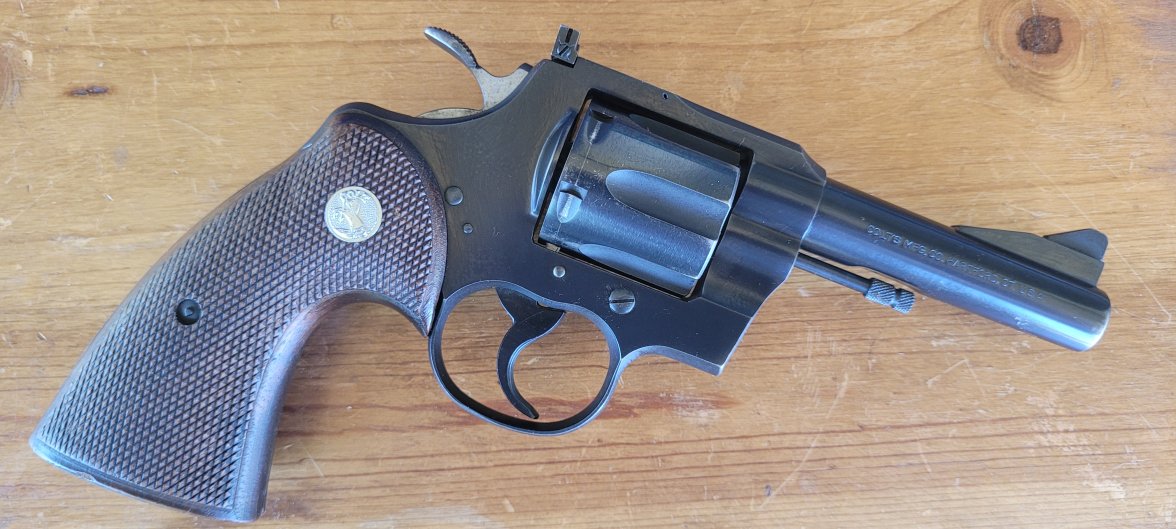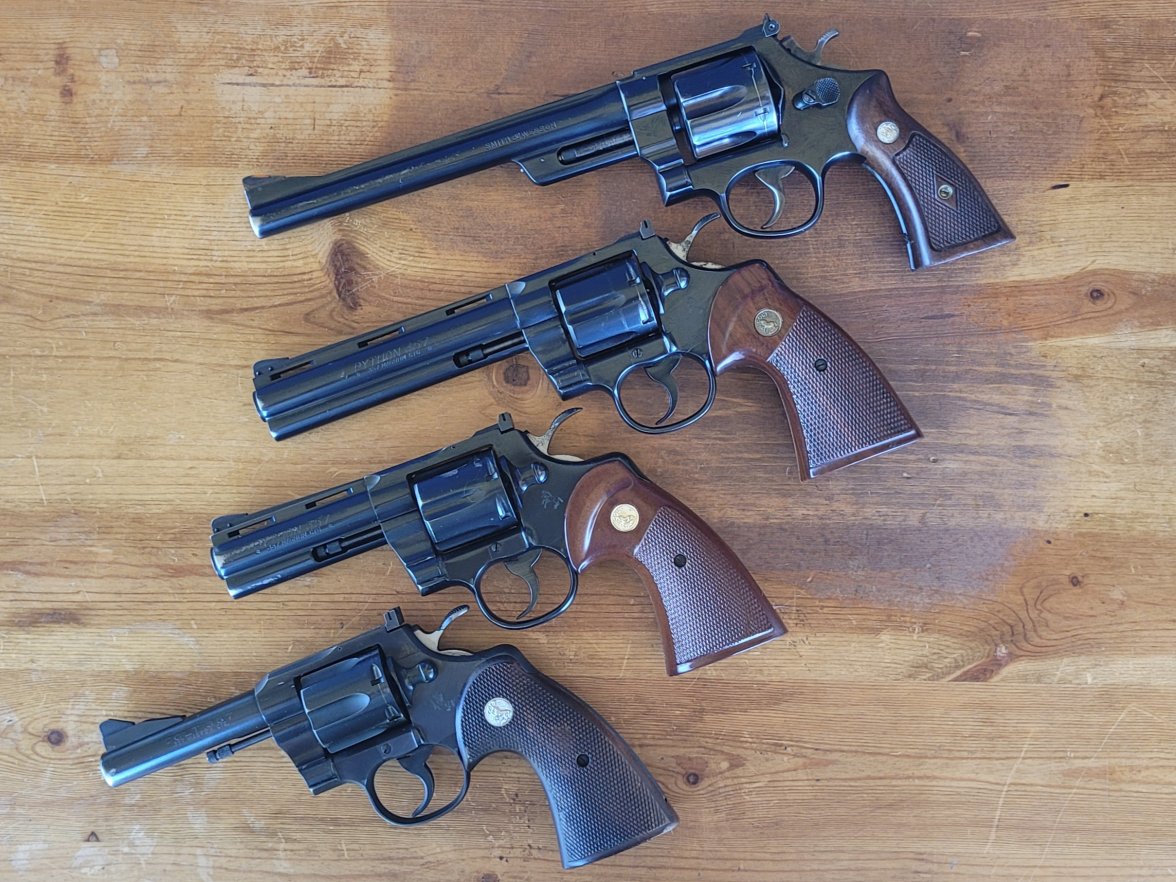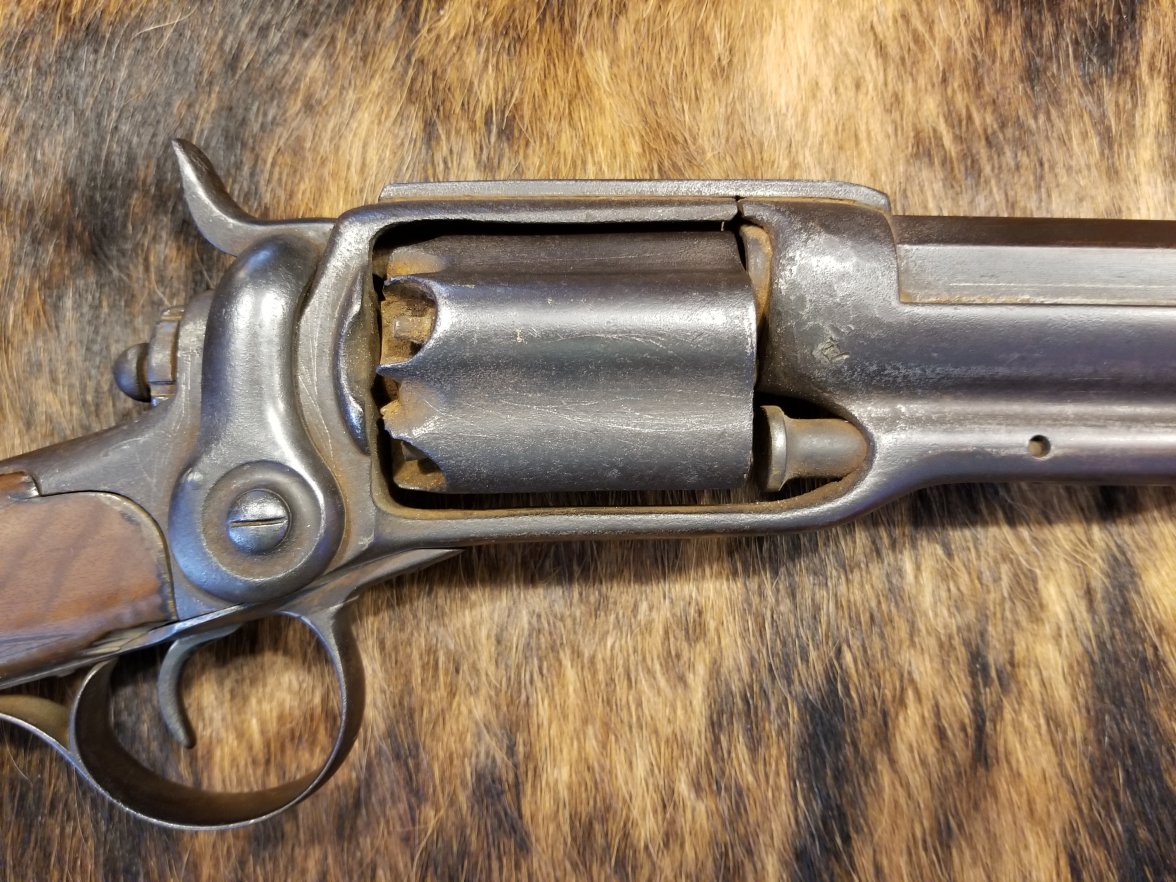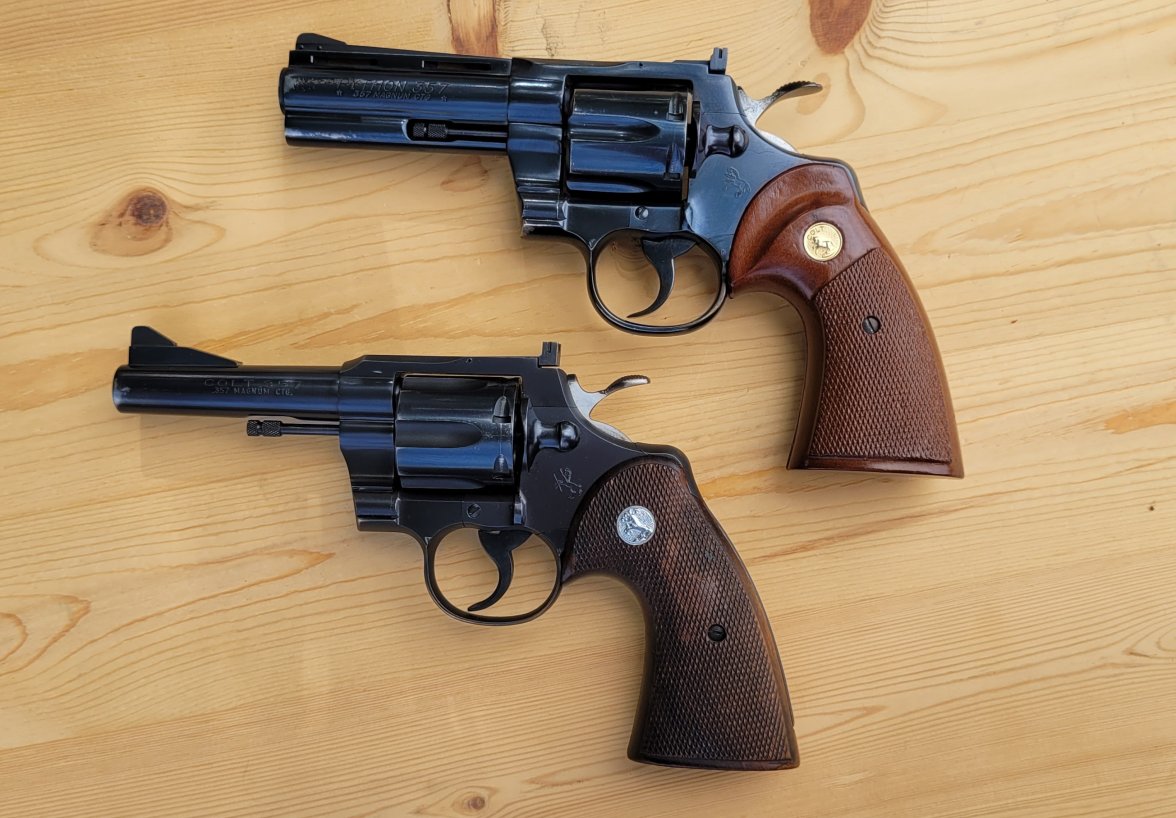So... any of our members here have an interest in firearms?
Waltesefalcon
·I just acquired this 1954 Colt 3-5-7. It's in what I'd call 90% condition, showing some holster wear on the muzzle and cylinder. Mechanically it locks up tights and has good timing. The stocks are in overall good shape but a few of the high points have been knocked off the left stock near the trigger guard.
I suppose you could say I have a thing for target revolvers in .357. From top a 54 or 55 S&W .357, a 76 Colt Python, a 77 Colt Python, and my new 54 Colt 3-5-7.
I suppose you could say I have a thing for target revolvers in .357. From top a 54 or 55 S&W .357, a 76 Colt Python, a 77 Colt Python, and my new 54 Colt 3-5-7.
noelekal
··Home For Wayward WatchesOOOooo... Waltesefalcon! Yummy Colt-ness!
Well, and that long-snouted Smith & Wesson. Actually, I like vintage Smith & Wesson even better than I do Colt.
I'm curious how close in serial number range your 4-inch 3 5 7 Magnum is to the 6-inch 3 5 7 here. Don't recall its complete serial number, but it's 2800-and-something. It's an early one with the characteristic early features.
I have both a 3 5 7 and a Python, both with six inch barrels. Just between you and me and the gate post, I like the 3 5 7 best.
Well, and that long-snouted Smith & Wesson. Actually, I like vintage Smith & Wesson even better than I do Colt.
I'm curious how close in serial number range your 4-inch 3 5 7 Magnum is to the 6-inch 3 5 7 here. Don't recall its complete serial number, but it's 2800-and-something. It's an early one with the characteristic early features.
I have both a 3 5 7 and a Python, both with six inch barrels. Just between you and me and the gate post, I like the 3 5 7 best.
Waltesefalcon
·@noelekal , mine is in the low 400s.
noelekal
··Home For Wayward WatchesWell, yee haa!
That's 2400 lower than mine.
Mine was originally owned by a Brownwood, Texas policeman who sold it to the coliseum manager of a gun show location for which I did overnight security for some gun show promoter friends.
That's 2400 lower than mine.
Mine was originally owned by a Brownwood, Texas policeman who sold it to the coliseum manager of a gun show location for which I did overnight security for some gun show promoter friends.
warrydog
·I've always liked the look of full checkered grips of the 3 5 7 and first gen Pythons.
I sold my E-frame Trooper many years ago for college tuition payments, given my career path, not so sure that was a good idea. ; 0 )
I sold my E-frame Trooper many years ago for college tuition payments, given my career path, not so sure that was a good idea. ; 0 )
noelekal
··Home For Wayward WatchesWaltesefalcon
·Gorgeous trio @noelekal . Both of my Officer's Models are pre-war examples so they have the old style target stocks, not those beautiful 1st generation target stocks.
Wryfox
·Here's one I bet you've never seen in person.... Colt 1855 Revolving Shotgun
Large frame 10GA Deluxe Model w/36" barrel.
Based on Elisha Root's(Colt's Chief Engineer) side hammer revolving pistol design, scaled up basically.
It is exceedingly difficult to find any real information on these shotguns. Colt estimates only 1100 shotguns were made in 10ga(75 cal) Large frame and 20ga(60 cal) Small frame.
Approx 600 were 10ga, and 500 20 ga.. Deluxe were ~25% of production. 36" barrel is written as "extremely rare".
This puppy weighs 11lbs and is nearly 5ft long. Yeah, it's heavy and feels even heavier with the long barrel and cleaning rod rib and guides. I think I know why few got the 36" barrel.
Mechanically it functions perfectly. A HUGE plus. Unfortunately it cannot be disassembled due to the cylinder release button being frozen.
Also note that early on in its life the frame cracked(a common issue) and a reinforcing rib was added to restore it. The repair has the same level of aging as the rest of gun so I expect that it was used regularly after the repair.
All were made from 1860-1863.
Question for my OF firearms peeps.....take a look at the pics, do I clean it or leave the 100yrs of dust and rust alone?
Large frame 10GA Deluxe Model w/36" barrel.
Based on Elisha Root's(Colt's Chief Engineer) side hammer revolving pistol design, scaled up basically.
It is exceedingly difficult to find any real information on these shotguns. Colt estimates only 1100 shotguns were made in 10ga(75 cal) Large frame and 20ga(60 cal) Small frame.
Approx 600 were 10ga, and 500 20 ga.. Deluxe were ~25% of production. 36" barrel is written as "extremely rare".
This puppy weighs 11lbs and is nearly 5ft long. Yeah, it's heavy and feels even heavier with the long barrel and cleaning rod rib and guides. I think I know why few got the 36" barrel.
Mechanically it functions perfectly. A HUGE plus. Unfortunately it cannot be disassembled due to the cylinder release button being frozen.
Also note that early on in its life the frame cracked(a common issue) and a reinforcing rib was added to restore it. The repair has the same level of aging as the rest of gun so I expect that it was used regularly after the repair.
All were made from 1860-1863.
Question for my OF firearms peeps.....take a look at the pics, do I clean it or leave the 100yrs of dust and rust alone?
Edited:
noelekal
··Home For Wayward WatchesYeah Waltesefalcon, but yours have pre-war Colt craftsmanship and surface finish which I consider to be distinct smidgen superior to Colt post-war production standards.
World War II's necessarily rushed wartime production requirements forever changed the way firearms were produced and finished. That event was a Pandora's box, introducing all sorts of deletions of nice touches that once went into finished firearms with all the makers. Once released, those deletions have never been stuffed back in the box. Why, these days we have folks who admire the fine fit and finish of guns made of cast steel, aluminum alloy and ... plastic! Long as it has a durable black coating of some sort and looks all macho gnarly, tact-cool and like it was designed for the "Transformer" cartoons of the early 1990's they are happy.
Just showing my age and fogy-ness here.
One could argue that the interwar years were Colt's true golden age.
By the 1920s Colt's classic revolver designs had been in place for over a decade and while the pre-World War I Colt finish was unsurpassed by anything they later did, metallurgical advances and production technique refinements rendered some of the very finest revolvers Colt has ever produced. By the 1950s a little less attention was paid to production of those same classic designs and by 1970 when the old V-Spring Colt action began to be phased out, it becomes apparent that production corners were being cut on these same classic designs.
A 1908 vintage E-Frame Colt Army Special and a last year of production (1969-1970) E-Frame Official Police are the same breed of cat design wise, right down to small component parts, and the late vintage E-Frame will serve just as readily as the early one, but the difference in the details is apparent with any comparison of the two.
The Colt Mark III, introduced in 1970 to replace the D-Frame size in the Colt revolver line is a distinct step below the revered, and long serving D-Frame Colt derivative models, at least in my opinion, almost teeth-gnashingly so.
World War II's necessarily rushed wartime production requirements forever changed the way firearms were produced and finished. That event was a Pandora's box, introducing all sorts of deletions of nice touches that once went into finished firearms with all the makers. Once released, those deletions have never been stuffed back in the box. Why, these days we have folks who admire the fine fit and finish of guns made of cast steel, aluminum alloy and ... plastic! Long as it has a durable black coating of some sort and looks all macho gnarly, tact-cool and like it was designed for the "Transformer" cartoons of the early 1990's they are happy.
Just showing my age and fogy-ness here.
One could argue that the interwar years were Colt's true golden age.
By the 1920s Colt's classic revolver designs had been in place for over a decade and while the pre-World War I Colt finish was unsurpassed by anything they later did, metallurgical advances and production technique refinements rendered some of the very finest revolvers Colt has ever produced. By the 1950s a little less attention was paid to production of those same classic designs and by 1970 when the old V-Spring Colt action began to be phased out, it becomes apparent that production corners were being cut on these same classic designs.
A 1908 vintage E-Frame Colt Army Special and a last year of production (1969-1970) E-Frame Official Police are the same breed of cat design wise, right down to small component parts, and the late vintage E-Frame will serve just as readily as the early one, but the difference in the details is apparent with any comparison of the two.
The Colt Mark III, introduced in 1970 to replace the D-Frame size in the Colt revolver line is a distinct step below the revered, and long serving D-Frame Colt derivative models, at least in my opinion, almost teeth-gnashingly so.
Waltesefalcon
·Wry, I've always liked the Root design. That shotgun is an absolutely amazing piece, congratulations on it, it's a fantastic example. I'd probably do a little sympathetic cleaning on it but nothing heavy.
Waltesefalcon
·Noelekal, I agree with you about pre-WWII Colts being the pinnacle of their craftsmanship, which is why I try to mostly collect them. I will say that the immediate post-war guns still held a great amount of workmanship and when looking at either my or your 3-5-7 or one of your Officer's Models you can still see that high level of attention to detail and fine finishing. The duotone finish on the 3-5-7 is a good example of that.
noelekal
··Home For Wayward WatchesYep, Duotone!
A difference in surface texture rather than surface color. Bright finish except for a pleasing soft satin finish within each cylinder flute, the bottom of the trigger guard, and top and rear of of the revolver's frame. Practical for its anti reflective qualities on the frame, wear resistance on the trigger guard, and just because it offered a bit of distinctive contrast in the cylinder flutes. Colt only provided the Duotone finish from 1952 to 1955 then skipped the required steps for Duotone preparation when finishing the revolvers, polishing them uniformly.
Looks more distinctive in person than in my poor photographs.

My trigger guard has a spot of honest holster wear on the trigger guard finish. This 3 5 7 was a working gun for a lawman.


Only the first year of production 3 5 7s had the Colt Accro rear sight with the rounded front sight base and came with the muzzle highly polished and left bright. Subsequent years of 3 5 7 production found the muzzle left blued after the finish process and the rear sight base's front was squared off.


More obscure and esoteric stuff about the Colt 3 5 7 than anyone would ever want to know.
I have this 1953 vintage Colt Official Police revolver on hand. It came with the neato Duotone effect though it is muted due to the revolver's wear. This revolver was a New York Police Department gun. Shown with the typical Jay-Pee issue holster equipment. The Official Police was the renamed Colt Army Special. Both the Army Special and the Official Police were the plebeian work horse Colt revolvers in lawmen's holsters for over 60 years.

NYPD officer's badge number appearing on the revolver's rear grip frame.

The '53 Official Police shown with its World War II bud, the Colt Commando. The Colt Commando was simply the Official Police gone off to war. Sporting a rough finish and molded plastic grips, it was intended as a substitute standard side arm and also to assist with arming guards at American defense plants and other war critical facilities. The government contract requested deletion of the particular polishing steps Colt provided on its commercial production as well as a more durable finish applied. No checkered walnut stocks were wanted, but inexpensive and utilitarian plastic would do. Revolver production down and dirty reflects the rush of the times.

The predecessor to the Colt Official Police, this Colt Army Special dates to 1925 and is less common because it is chambered in .41 Long Colt rather than the ubiquitous .38 Special for which the great majority of these E-Frame Colt models were chambered. The .41 Long Colt is long obsolete, but I handload for the cartridge so shoot the hooey out of this one.

One more old Colt to finish out what Waltesefalcon started here. This big Colt New Service (U.S. contract Model 1909) dates to 1910. Displaying some wear, nonetheless the fabulous Colt blue finish shows through. Nothing touches the Colt products of the late 19th century and first decade of the 20th century for beautiful blue finish. And to think this was purchased for issue to troops with such a fine finish! All but about 300 of the entire Model 1909 contract production went to the Philippines where they were sorely needed at the time. The revolvers all promptly turned brown in the humidity and hard use and that is the way most are found today. This one was likely one of the 300 which stayed stateside and also was not likely to have been issued at all before it was "mustered out" of service in 1920, when a gun club friend's dad bought five of the Model 1909 revolvers and 500 rounds of .45 Colt ammunition from the San Antonio Arsenal in 1920, four to arm nightwatchmen at the ice production, dairy production, and ice cream production plant for whom he was the plant superintendent. The fifth one came home to the Lawson household where my then 13 year old friend appropriated it and most of the 500 rounds of ammunition also purchased from the government facility, for use on the family ranch near Kerrville, Texas northwest of San Antonio and at another family ranch in Mexico, west of Victoria. I'm guessing the wear occurred after the revolver left government stores. Cost of the five revolvers? Five dollars each. Ammunition? One cent per round.


My favorite style of Rampant Colt logo, the prancing pony framed by the stylized "C," used in the first decade of the 20th century. Can you tell it was a partly cloudy November afternoon when the photo was taken? The flawless polishing was applied prior to bluing by some nameless Colt craftsman in Hartford Connecticut for probably 50 cents per day wages.



A difference in surface texture rather than surface color. Bright finish except for a pleasing soft satin finish within each cylinder flute, the bottom of the trigger guard, and top and rear of of the revolver's frame. Practical for its anti reflective qualities on the frame, wear resistance on the trigger guard, and just because it offered a bit of distinctive contrast in the cylinder flutes. Colt only provided the Duotone finish from 1952 to 1955 then skipped the required steps for Duotone preparation when finishing the revolvers, polishing them uniformly.
Looks more distinctive in person than in my poor photographs.

My trigger guard has a spot of honest holster wear on the trigger guard finish. This 3 5 7 was a working gun for a lawman.


Only the first year of production 3 5 7s had the Colt Accro rear sight with the rounded front sight base and came with the muzzle highly polished and left bright. Subsequent years of 3 5 7 production found the muzzle left blued after the finish process and the rear sight base's front was squared off.


More obscure and esoteric stuff about the Colt 3 5 7 than anyone would ever want to know.
I have this 1953 vintage Colt Official Police revolver on hand. It came with the neato Duotone effect though it is muted due to the revolver's wear. This revolver was a New York Police Department gun. Shown with the typical Jay-Pee issue holster equipment. The Official Police was the renamed Colt Army Special. Both the Army Special and the Official Police were the plebeian work horse Colt revolvers in lawmen's holsters for over 60 years.

NYPD officer's badge number appearing on the revolver's rear grip frame.

The '53 Official Police shown with its World War II bud, the Colt Commando. The Colt Commando was simply the Official Police gone off to war. Sporting a rough finish and molded plastic grips, it was intended as a substitute standard side arm and also to assist with arming guards at American defense plants and other war critical facilities. The government contract requested deletion of the particular polishing steps Colt provided on its commercial production as well as a more durable finish applied. No checkered walnut stocks were wanted, but inexpensive and utilitarian plastic would do. Revolver production down and dirty reflects the rush of the times.

The predecessor to the Colt Official Police, this Colt Army Special dates to 1925 and is less common because it is chambered in .41 Long Colt rather than the ubiquitous .38 Special for which the great majority of these E-Frame Colt models were chambered. The .41 Long Colt is long obsolete, but I handload for the cartridge so shoot the hooey out of this one.

One more old Colt to finish out what Waltesefalcon started here. This big Colt New Service (U.S. contract Model 1909) dates to 1910. Displaying some wear, nonetheless the fabulous Colt blue finish shows through. Nothing touches the Colt products of the late 19th century and first decade of the 20th century for beautiful blue finish. And to think this was purchased for issue to troops with such a fine finish! All but about 300 of the entire Model 1909 contract production went to the Philippines where they were sorely needed at the time. The revolvers all promptly turned brown in the humidity and hard use and that is the way most are found today. This one was likely one of the 300 which stayed stateside and also was not likely to have been issued at all before it was "mustered out" of service in 1920, when a gun club friend's dad bought five of the Model 1909 revolvers and 500 rounds of .45 Colt ammunition from the San Antonio Arsenal in 1920, four to arm nightwatchmen at the ice production, dairy production, and ice cream production plant for whom he was the plant superintendent. The fifth one came home to the Lawson household where my then 13 year old friend appropriated it and most of the 500 rounds of ammunition also purchased from the government facility, for use on the family ranch near Kerrville, Texas northwest of San Antonio and at another family ranch in Mexico, west of Victoria. I'm guessing the wear occurred after the revolver left government stores. Cost of the five revolvers? Five dollars each. Ammunition? One cent per round.


My favorite style of Rampant Colt logo, the prancing pony framed by the stylized "C," used in the first decade of the 20th century. Can you tell it was a partly cloudy November afternoon when the photo was taken? The flawless polishing was applied prior to bluing by some nameless Colt craftsman in Hartford Connecticut for probably 50 cents per day wages.



Edited:
Waltesefalcon
·To build upon what Noelekal was talking about here is a side by side of my 3-5-7 and my Python, they are separated by about twenty years. Now both guns were service side arms, so both show some holster wear. In the first photo you can see the differences in the rear sights, as well as, the finer checkering on the hammer of the 3-5-7. The second photo shows the bright polished crown of the 3-5-7next to the blued crown of the Python. The third photo shows the flat finish on the back strap of the 3-5-7 compared to the bright blue of the Python. The fourth is just a side by side. And the last photo is my attempt to show off the duotone finish, which is difficult to show in pictures, as Noelekal pointed out. I'll stop here before getting into my prewar stuff. I think that Noelekal and I could probably go on for awhile about all the little things that make prewar Colts really special guns.
Wetworks
·Living in NYC, I've been hard-pressed in coming up with a viable SA rifle to add to the collection. Anyone want to take a stab at what I have incoming?
warrydog
·Thanks guys for posting photos of your wonderful E and I framed Colts (and others too).
The Officers models and Troopers have always been IMHO some of the most beautiful revolvers ever made.
Tom
The Officers models and Troopers have always been IMHO some of the most beautiful revolvers ever made.
Tom
Waltesefalcon
·Living in NYC, I've been hard-pressed in coming up with a viable SA rifle to add to the collection. Anyone want to take a stab at what I have incoming?
I'm willing to bet the only legal guns in NYC are muzzle loaders, so I'll say it's a Brown Bess.
Wetworks
·I'm willing to bet the only legal guns in NYC are muzzle loaders, so I'll say it's a Brown Bess.
Settled in on a Springfield Armory M1A Scout Squad, should have it Friday! Unfortunately there were no NY compliant models with walnut stocks available, so I went synthetic. Also, apparently I can't order ammo online, so I have to hope either the FFL has 308, or I will have to trudge to a store which does.
SkunkPrince
·Lol, well the current governor did say she's willing to bring back muskets!!!
Settled in on a Springfield Armory M1A Scout Squad, should have it Friday! Unfortunately there were no NY compliant models with walnut stocks available, so I went synthetic. Also, apparently I can't order ammo online, so I have to hope either the FFL has 308, or I will have to trudge to a store which does.
Actually, I would have bought the left-handed version. And, you can always change your stock.
Waltesefalcon
·Lol, well the current governor did say she's willing to bring back muskets!!!
Settled in on a Springfield Armory M1A Scout Squad, should have it Friday! Unfortunately there were no NY compliant models with walnut stocks available, so I went synthetic. Also, apparently I can't order ammo online, so I have to hope either the FFL has 308, or I will have to trudge to a store which does.
Wait, doesn't a synthetic stock make it more dangerous and a Walnut stock make it more friendly?














